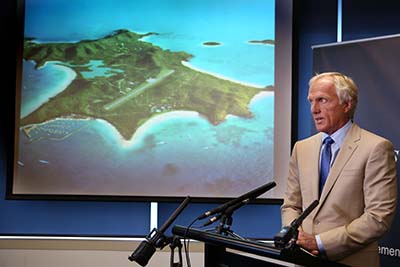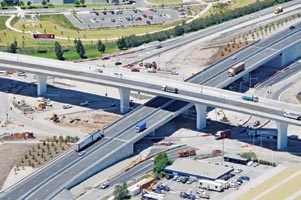Capricorn region upset by Great Keppel resort missing out on casino
NEWS this week that the Greg Norman backed Great Keppel Island revitalisation development has missed out on a casino licence is unbelievable, according to the region’s peak tourism and economic development organisation, Capricorn Enterprise.
“I am bitterly disappointed that Central Queensland and the southern Great Barrier Reef has missed out on this opportunity, particularly considering that GKI is one of the few applicants with all the necessary approvals in place for integrated resort development,” Capricorn Enterprise chief executive Mary Carroll said.
“Aquis proposal by Tony Fung at Yorkeys Knob in Cairns ($8.15 billion) and the ASF Consortium Broadwater Marine project ($7.5 billion) at the Gold Coast haven’t even got their approvals in place.
“ASF haven’t even submitted its EIS,” she said.
Ms Carroll spoke immediately after the State Government announcement with developer Tower Holdings. She said Tower was still considering this latest announcement before providing any formal comment.
“Tower Holdings is in the middle of their international investment campaign led by Greg Norman and this announcement will certainly change the goal posts in respect to investment opportunities” Ms Carroll said.
“Tower Holdings has stated previously that the development will proceed regardless of a casino licence, but this announcement does change the sales pitch” she said.
Ms Carroll said from the perspective of the Capricorn region’s tourism development the “announcement is a great shame for our destination and Tower Holdings as a fully owned Australian company.”
Renwned Australian golfer and course developer Greg Norman is heading up an international drive for investment in the unique tourism resort development on Great Keppel Island, the southernmost point of the Great Barrier Reef near Yeppoon. 
Mr Norman launched the campaign from Brisbane in April seeking investors to build and operate the largest fully approved, multi-faceted tourism infrastructure project currently in Australia.
Mr Norman is the ambassador for the A$2 billion Tower Holdings development on the island, which includes an 18-hole championship golf course designed by him. Along with his Great White Shark Enterprises, global agents JLL have been engaged to source international investors and the prominent investment bank, Moelis & Company, has been engaged as lead financial advisor to the project.
These three groups have combined to promote investment in the project, which is the largest and possibly last of its kind on the World Heritage-listed Great Barrier Reef. Initial interest has already been fielded with a formal investment campaign started in May.
Great Keppel is one of the reef’s most accessible islands – more than twice the size of Hamilton Island and a 50 minute flight from Brisbane.
The integrated resort development has approval for 700 luxury villas, 350 luxury apartments, a five-star golf course, beachfront hotel, marina, airstrip and retail village.
Owner, Tower Holdings CEO Terry Agnew said the campaign was being launched at a time when Australia was seeking crucial investment in five-star tourism product to meet the demands and expectations from the booming Asian travel market.
Great Keppel has a casino zoning and Tower Holdings lodged a submission to the Queensland Government’s invitation for integrated resort developments seeking a casino licence.
Queensland Tourism Industry Council CEO Daniel Gschwind said there had not been a development of this scale in Queensland for more than 25 years.
“New five-star tourism products and experiences will allow Queensland to tap into the enormous tourism growth potential, particularly the rising number of wealthy Asian travellers,” Mr Gschwind said.
JLL CEO Australia Stephen Conry said Great Keppel Island represented “one of those rare opportunities with an extremely well planned development, set to deliver great returns, with full government support to develop the project”.
“The realization of the potential for five star facilities on the Great Barrier Reef is unquestionable and this investment opportunity has many attractive features, not least its position in one of the world’s most pristine locations in a country that has considerable growth projections for tourism in the region,” Mr Conry said.
Tourism Australia’s general manager of destination development, Katherine Droga said Australian tourism was performing well, with a record 6.5 million international visitors in 2013 spending more than $28 billion.
“The enduring appeal of our country remains strong, but to maintain and grow demand we certainly can’t afford to sit on our laurels,” Ms Droga said.
“Investment in new tourism infrastructure has a critical part to play in Australia maintaining its global competitiveness and continuing to attract visitors who are going to stay longer, travel further and, ultimately, spend more.
“Great Keppel Island is an exciting project and represents just the kind of investment story and ‘new news’ our industry needs to keep Australia and our world class visitor experiences front of mind for both international travellers and the broader investment community,” she said.
Mr Norman was enthusiastic about the potential for investment from world leading operators.
“I have not seen a project like this anywhere in the world,” he said. “I have travelled to great islands all over the world and there is nothing like this place and nothing like the Great Barrier Reef.
“The magnitude and beauty of Great Keppel Island makes it a magnificent site, and as a Queenslander I am very honoured to be involved with bringing this vision to reality.
“Australia has lost a little of its panache in our international tourism market and this project is important for Australia – for our locals and for attracting luxury visitors back to Australia,” Mr Norman said.
ends
POSTED MAY 27, 2014

 How to resolve AdBlock issue?
How to resolve AdBlock issue?  AUSTRALIA’s economic growth is being held back because of major underinvestment in infrastructure, according to research by think-tank the ADC Forum.
AUSTRALIA’s economic growth is being held back because of major underinvestment in infrastructure, according to research by think-tank the ADC Forum. 



